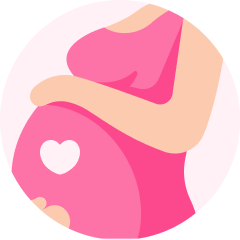Giving birth can feel very daunting, especially for first-time moms. This is why keeping yourself informed about what’s going to happen can help assuage some of the fears, and give you peace of mind.

Here’s what you need to know about the birth process.
What Happens When Giving Birth?
Contrary to what most people might see in films and television, giving birth is not as simple as just “pushing the baby out”.
In addition, the birth process during a vaginal delivery versus a cesarean section (C-section) is also different. Here’s what happens during each type of birth:
Labor Starts
You’ll know you’re ready to give birth once the signs of labour start. This usually includes rhythmic contractions that get stronger and your water bag breaking.
This is when you should head to the hospital, and when you’re settled in, nurses will check in with you every 1-4 hours, depending on how far into labour you are. A doctor or midwife will perform a baseline vaginal examination to check how dilated your cervix is. Periodic internal examination is done to determine how far along you are with labour, and if you’re about to give birth.

Giving Birth
Once you’re about to give birth, meaning the baby’s presenting part is already almost out, the doctor or midwife will be coaching you. They will ask you to lie down in a dorsal lithotomy position— with your knees flexed and legs spread apart. You will be guided every step of the way when you are to give birth.
This is the time when women start bearing down or “pushing” out the baby, and this can be very physically taxing. As the baby goes out of your vagina, you can experience some tearing and pain as it tries to accommodate your baby coming out.
During the early part of labour, if the pain is too much, you can ask your doctor to give you an epidural for “painless” labour. If you find the pain tolerable, this may be skipped but during repair of the vagina, rest assured you will be given local anesthesia to numb the area being stitched.

After Giving Birth
Once the baby comes out, you’re probably breathing a sigh of relief, as the “worst” is over. However, you will still be experiencing uterine contractions as your body tries to push out your placenta.
Thankfully, this happens relatively smoothly, and it usually takes just an additional push before your placenta slips out of your body.
This is also the time that you get to be with your baby. You can even immediately start breastfeeding after giving birth. This is ideal as your baby needs all the nutrients your breastmilk provides.
What Happens During a C-Section?
In contrast with a natural birth, there are several differences in the birth process of a C-section. In most cases, a C-section occurs if labour is taking too long, or if the baby is in a breech or transverse position, which can be very dangerous for a natural birth. Your doctor might also recommend a C-section if the baby’s heart rate drops during labour.
However, some moms also opt to have a C-section as their preference instead of giving birth naturally.
Here’s a breakdown of what happens:
Before the Procedure
Once your doctor has decided to push through with a C-section, you will be given anaesthesia to numb the pain. You won’t feel anything from your torso downwards, though you might feel some movement or slight pressure.
Some mothers will be staying awake throughout the procedure. However, some circumstances require general anaesthesia.

During the C-Section
Your doctor will make an incision in your abdomen, and your baby will be delivered through that incision t. The process is relatively fast, and the operation may range from less than an hour to a half.
Once the baby has been delivered, your doctor will repair your uterus and abdomen in layers.

After the C-Section
You might feel some pain as the anaesthesia wears off, and you’ll also need to take care of your wound. You’ll also be able to spend time immediately with your baby and breastfeed.
[embed-health-tool-bmi]
















